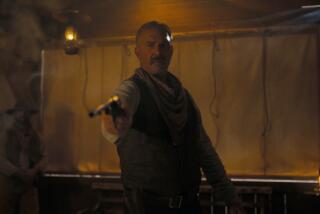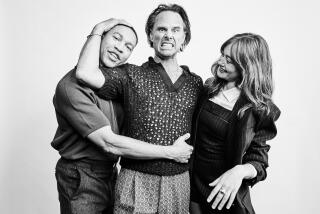With a new ‘Point Break,’ bringing seriousness to a camp classic
Of all the tricky feats in filmmaking, few are more difficult than revisiting a beloved bad movie.
Rejuvenating a forgotten stinker is easy — you have plenty of latitude and no stakeholders. An enduring classic? That’s “Star Wars: The Force Awakens.”
But reclaiming the magic when there wasn’t much to begin with is a particular challenge.
In 1991, long before she won an Oscar, Kathryn Bigelow directed “Point Break.” Improbably coupling the worlds of surfers and bank robbers, it was not the pinnacle of cinematic achievement; the term would more likely be applied to movies that don’t feature mooning as a key plot point.
SIGN UP for the free Indie Focus movies newsletter >>
Yet the film — with colorfully named and conceived characters such as FBI agent Johnny Utah — caught on. Released at the convergence of the “Bill and Ted’s Excellent Adventure” era of Southern California zen and that post-”21 Jump Street” moment in which cops could go seemingly anywhere as long as they were “undercover,” “Point Break” drew a solid audience (in today’s dollars, the equivalent of “The Intern” or “Goosebumps”) and continued to rise with the stock of Keanu Reeves (Utah) and Patrick Swayze (robber/surfer-in-chief Bodhi).
Camp status was conferred in 2003 with “Point Break Live!,” a show, now staged across the country, that made the movie’s badness its point. “Point Break” was a viral sensation in an age before viral sensations.
So how, exactly, do you create a new “Point Break?”
“It’s hard to reproduce cheese,” admitted producer Broderick Johnson.
“I mean, how do you copy someone eating the … end of a meatball sandwich?” added fellow producer Andrew Kosove, alluding to a Gary Busey line from the original.
Their answer: Don’t even try.
After years of development in a campier direction, Alcon Entertainment’s Johnson and Kosove hired as their director Ericson Core (“Invincible,” but primarily known as a cinematographer on such practical-effects pictures as “The Fast and The Furious”). When Core’s movie hits theaters on Christmas Day, viewers might be surprised at what they see.
Instead of drafting off a quarter-century of “Point Break” canon, filmmakers have gone another route. Their new movie is a hyper-earnest eco-adventure featuring a slew of extreme sports set pieces — Naomi Klein activism by way of the X Games.
“When I first heard about a new ‘Point Break’ I was negative too. It just didn’t seem like a good idea,” Core said in an interview. “But as we got into it, it became not a remake but ‘what if you took the themes and ideologies of the original characters and put them in the world of 25 years later?’ That turns out to be a very different film.”
Said film implicitly poses a question yet unasked in this age of constant Hollywood reboots: Can a piece of camp be mined for something other than its comedy?
Or put another way: We’re a long way from Keanu intoning “The correct term is babes.”
Some character names and loose structural elements are the same. In both movies, an athlete named Johnny Utah goes undercover in an extreme-sports world to root out criminals. But in Core’s version, Utah (Australian actor Luke Bracey) is not a former college football quarterback but an X Games type known for his motocross and other skills. He joins the FBI for very specific reasons — after a personal tragedy for which he feels guilty — and soon finds himself embedded with Bodhi (Edgar Ramirez).
The ringleader this time heads up not a band of bank-robbing surfers but a more mysterious group that has unsmilingly undertaken a series of globetrotting extreme-sports challenges devised by a late Asian mystic. Those challenges, and not the occasional sincere patter between the characters (“We don’t live off the grid — we live on it, but on our own terms.”), dominate the action. This is a movie less about the relationship between Bodhi and Utah than the relationship all men have with nature.
Also distinguishing the remake is the gang’s motive. Theft to support their lifestyle in the post-Reagan boom is out. In? A Robin Hood-style ethos of redistributing wealth among the poor. (Pulling an aerial heist and then dropping money over a third-world village.)
“These guys are still railing against the system,” Ramirez said. “But the system is very different.”
Added Core: “It would have been weird just to have them rob banks to surf an endless summer.”
The biggest difference, however, lies with the physical stunts.
The original focused on just a few sports — primarily surfing — and used cranes and other Hollywood trickery to portray them. The new movie eschewed all of that — and the 21st century call of the green screen -- to physically haul from one exotic location to another (there are 11 in all) staging the feats as they would in real life. There’s wingsuit flying off the Swiss Alps and free climbing off Angel Falls in Venezuela. Neither sport was included in — or, in the case of wingsuit flying, invented at the time of — the original film.
Even the sports that were, such as surfing and motocross, are handled differently here; the production went to the renowned wave spot of Teahupo’o in Tahiti, for instance, to film the surfing shots. “When you see two robots fighting in a movie these days you know it was done on a computer and it takes you out of it.” said Jeb Corliss, the BASE jumper and wingsuit flyer who served as a consultant. “Because everything here is real, it puts you right into it.”
The practical locations marked a closing of the circle, he and the cast said, since the original film inspired many modern-day extreme athletes to take up their sports in the first place. “To me the biggest approval is when the real athletes say we got it right,” Bracey said. He said he felt that helped distinguish this movie from the original, but “the bones and the inherent drive are the same.”
Needless to say, none of these action set pieces came cheap — the budget reached $105 million, defrayed in part by the Chinese company DMG Entertainment (Alcon primarily financed; Warner Bros. is distributing). Nor were they easy.
Tahiti required waiting days for the right swells. On several European jumping scenes, Core, who also previously trained as a mountain ranger, would hike up with a small crew and wait hours for safe conditions. In Venezuela, the production had to negotiate with a local general for a helicopter to get them and serveral tons of equipment out.
“The movie,” Kosove said, “was more of an expedition than a production.”
That was particularly true in a piece de resistance scene involving wingsuit flying, a nascent and dangerous sport in which a special suit that increases surface area allows humans to soar miles high up in the air. Filmed amid the peaks Walenstadt, Switzerland, the scene shows Bodhi and Utah challenging themselves by hiking up a mountain and then flying down — and out — across the Alps backdrop.
The scene required four stuntmen flying in formation, shot from below, and a fifth rigged with a camera flying behind them; all weaved through narrow mountain passes. The production would cancel planned flights on a number of days because of poor weather conditions, eventually completing it only after two weeks.
“I’ve been on a lot of sets where they say they’re going to do a big stunt and then you get to the day and they’re too scared and say ‘we don’t have insurance’ or whatever it is. And these guys never did that,” Corliss said.
(The on-location aspects, it should be said, provided other benefits: With so many internationally shot scenes, the film has its eye set on the global market. An early release in a number of Asian territories has already netted $43 million.)
Shortly before production began in Berlin, Core got the cast and crew together to watch the original “Point Break.” There had been little discussion with that movie’s principals — Bracey didn’t talk to Reeves, and Core did not reach out to Bigelow, though Ramirez, who had a role in “Zero Dark Thirty,” did seek and received the director’s blessing.
Still, Core wanted the cast and crew to understand what they were going for. “We had very long conversations about the message of the first film — plugging in to the world at large, and not with the computer or the Internet, but with whatever each individual should do with their lives and find their own path,” Core said. “I wanted them to be aware of that.”
A big part of the appeal for viewers will be the sports writ large. There’s indeed something powerful about seeing them in this way — as popular and viewed as YouTube videos are, most people haven’t seen these sports performed in full 3-D relief.
Still, whether audiences want a holiday moviegoing experience driven primarily by spectacle remains to be seen. Already the emphasis on the physical over the narrative has earned some mixed reviews. In Variety, a critic wrote that Core “has poured his expertise into devising jaw-dropping stunts and visualizing awesome natural wonders. But the sense of living dangerously is somewhat lacking as Kurt Wimmer’s emotionally vacant screenplay fails to make audiences care enough about the characters to sweat over their physical exertions.”
And it’s an open question how the movie plays in a world where the core audience for “Point Break” is a group that’s familiar with, well, “Point Break. “The biggest challenge has been dispelling the idea that it’s a remake. If people look for the original film they’ll be disappointed,” Core said.
Fans will almost certainly be relieved that the surf-heavy original is not heavily tinkered with or capitalized on. But they might ask another question: If it’s all played so straight-faced, why call the movie “Point Break”? Is, in other words, a film with this name that eschews much of what the title implies a kind of cinematic duck dive?
Those who star in it disagree, saying there’s value in extending the mythology.
“The first remake of ‘Point Break’ was really ‘The Fast and the Furious.’ And they made that seven times!” Ramirez said. “There’s always room for a new movie.”
Bracey added a meta point. “Of course it’s a challenge making a new “Point Break.’ But that’s the spirit of ‘Point Break’ — it’s taking an obstacle in front of you and seeing if you can overcome it.”
Now that’s the kind of Zenmaster wisdom Keanu would appreciate.
You Might Also Like:
After a big ‘Star Wars’ weekend, can other holiday movies find wiggle room?
The Big Short’s genius is also one of its key obstacles
At AFI Fest, Concussion throws down a gauntlet to the NFL
More to Read
Only good movies
Get the Indie Focus newsletter, Mark Olsen's weekly guide to the world of cinema.
You may occasionally receive promotional content from the Los Angeles Times.











